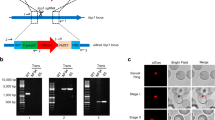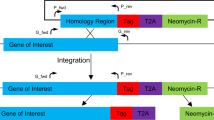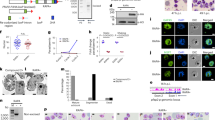Abstract
Toxoplasma gondii, an obligate intracellular parasite of the phylum Apicomplexa, can cause severe disease in humans with an immature or suppressed immune system. The outcome of Toxoplasma infection is highly dependent on the strain type, as are many of its in vitro growth properties1. Here we use genetic crosses between type II and III lines to show that strain-specific differences in the modulation of host cell transcription are mediated by a putative protein kinase, ROP16. Upon invasion by the parasite, this polymorphic protein is released from the apical organelles known as rhoptries and injected into the host cell, where it ultimately affects the activation of signal transducer and activator of transcription (STAT) signalling pathways and consequent downstream effects on a key host cytokine, interleukin (IL)-12. Our findings provide a new mechanism for how an intracellular eukaryotic pathogen can interact with its host and reveal important differences in how different Toxoplasma lineages have evolved to exploit this interaction.
This is a preview of subscription content, access via your institution
Access options
Subscribe to this journal
Receive 51 print issues and online access
$199.00 per year
only $3.90 per issue
Buy this article
- Purchase on Springer Link
- Instant access to full article PDF
Prices may be subject to local taxes which are calculated during checkout





Similar content being viewed by others
References
Saeij, J. P., Boyle, J. P. & Boothroyd, J. C. Differences among the three major strains of Toxoplasma gondii and their specific interactions with the infected host. Trends Parasitol. 21, 476–481 (2005)
Howe, D. K. & Sibley, L. D. Toxoplasma gondii comprises three clonal lineages: correlation of parasite genotype with human disease. J. Infect. Dis. 172, 1561–1566 (1995)
Darde, M. L., Bouteille, B. & Pestre-Alexandre, M. Isoenzyme analysis of 35 Toxoplasma gondii isolates and the biological and epidemiological implications. J. Parasitol. 78, 786–794 (1992)
Grigg, M. E., Ganatra, J., Boothroyd, J. C. & Margolis, T. P. Unusual abundance of atypical strains associated with human ocular toxoplasmosis. J. Infect. Dis. 184, 633–639 (2001)
Howe, D. K., Honore, S., Derouin, F. & Sibley, L. D. Determination of genotypes of Toxoplasma gondii strains isolated from patients with toxoplasmosis. J. Clin. Microbiol. 35, 1411–1414 (1997)
Fuentes, I., Rubio, J. M., Ramirez, C. & Alvar, J. Genotypic characterization of Toxoplasma gondii strains associated with human toxoplasmosis in Spain: direct analysis from clinical samples. J. Clin. Microbiol. 39, 1566–1570 (2001)
Khan, A. et al. Genotyping of Toxoplasma gondii strains from immunocompromised patients reveals high prevalence of type I strains. J. Clin. Microbiol. 43, 5881–5887 (2005)
Darde, M. L., Villena, I., Pinon, J. M. & Beguinot, I. Severe toxoplasmosis caused by a Toxoplasma gondii strain with a new isoenzyme type acquired in French Guyana. J. Clin. Microbiol. 36, 324 (1998)
Carme, B. et al. Severe acquired toxoplasmosis in immunocompetent adult patients in French Guiana. J. Clin. Microbiol. 40, 4037–4044 (2002)
Tusher, V. G., Tibshirani, R. & Chu, G. Significance analysis of microarrays applied to the ionizing radiation response. Proc. Natl Acad. Sci. USA 98, 5116–5121 (2001)
Khan, A. et al. Composite genome map and recombination parameters derived from three archetypal lineages of Toxoplasma gondii. Nucleic Acids Res. 33, 2980–2992 (2005)
Broman, K. W., Wu, H., Sen, S. & Churchill, G. A. R/qtl: QTL mapping in experimental crosses. Bioinformatics 19, 889–890 (2003)
Ihle, J. N. The Stat family in cytokine signaling. Curr. Opin. Cell Biol. 13, 211–217 (2001)
Bradley, P. J. et al. Proteomic analysis of rhoptry organelles reveals many novel constituents for host-parasite interactions in Toxoplasma gondii. J. Biol. Chem. 280, 34245–34258 (2005)
Hakansson, S., Charron, A. J. & Sibley, L. D. Toxoplasma evacuoles: a two-step process of secretion and fusion forms the parasitophorous vacuole. EMBO J. 20, 3132–3144 (2001)
Gilbert, L. A., Ravindran, S., Turetzky, J. M., Boothroyd, J. C. & Bradley, P. J. Toxoplasma gondii targets a protein phosphatase 2C to the nucleus of infected host cells. Eukaryot. Cell (published online 3 November 2006; doi:10.1128/EC/00309-06).
Robben, P. M. et al. Production of IL-12 by macrophages infected with Toxoplasma gondii depends on the parasite genotype. J. Immunol. 172, 3686–3694 (2004)
Butcher, B. A. et al. IL-10-independent STAT3 activation by Toxoplasma gondii mediates suppression of IL-12 and TNF-alpha in host macrophages. J. Immunol. 174, 3148–3152 (2005)
Remaut, H. & Waksman, G. Structural biology of bacterial pathogenesis. Curr. Opin. Struct. Biol. 14, 161–170 (2004)
Suss-Toby, E., Zimmerberg, J. & Ward, G. E. Toxoplasma invasion: The parasitophorous vacuole is formed from host cell pasma membrane and pinches off via a fission pore. Proc. Natl Acad. Sci. USA 93, 8413–8418 (1996)
Limnander, A. et al. v-Abl signaling disrupts SOCS-1 function in transformed pre-B cells. Mol. Cell 15, 329–341 (2004)
Burg, J. L., Perelman, D., Kasper, L. H., Ware, P. L. & Boothroyd, J. C. Molecular analysis of the gene encoding the major surface antigen of Toxoplasma gondii. J. Immunol. 141, 3584–3591 (1988)
Chan, S. M. et al. Protein microarrays for multiplex analysis of signal transduction pathways. Nature Med. 10, 1390–1396 (2004)
Mital, J. et al. Conditional expression of Toxoplasma gondii apical membrane antigen-1 (TgAMA1) demonstrates that TgAMA1 plays a critical role in host cell invasion. Mol. Biol. Cell 16, 4341–4349 (2005)
Acknowledgements
This work was supported by grants from the NIH (to J.C.B., J.P.B. and M.W.W.), the Ellison Medical Foundation (to J.C.B.), the USDS (to M.W.W.) and the California Universitywide AIDS Research Program (to J.P.J.S. and S.C.). We thank K. Broman for help with R/qtl and the Stanford Functional Genomics Facility for the human cDNA microarrays used for this study.
Author Contributions J.P.J.S. and S.C. contributed equally to this work. J.P.J.S. performed the microarrays and pathway analyses. S.C. and J.P.J.S. performed the experiments in Fig. 3. S.C. performed the experiments in Fig. 4 and Fig 5. J.P.B., M.E.J. and M.W.W. performed the genetic crosses that produced the progeny D3X1 and JD4. J.P.B. genotyped D3X1 and JD4. J.P.J.S., S.C., J.P.B. and J.C.B. wrote the paper. All authors discussed the results and commented on the manuscript.
The microarray data have been deposited in ArrayExpress with the accession number E-MEXP-783.
Author information
Authors and Affiliations
Corresponding author
Ethics declarations
Competing interests
The authors declare no competing financial interests.
Supplementary information
Supplementary Figures
This file contains Supplementary Figures 1-6 with legends, Supplementary Methods and additional references. (PDF 1410 kb)
Supplementary Data 1
This file contains Supplementary Data 1 with the array data (Log2 of Cy5/Cy3 normalized ratio (median)) for the genes indicated in Figure 1 (XLS 58 kb)
Supplementary Data 2
This file contains Supplementary Data 2 with the raw array data (Log2 of Cy5/Cy3 normalized ratio (median)) for all cDNAs. For the cDNAs that mapped significantly to a Toxoplasma genetic marker the LOD-score value at each genetic marker is indicated. (XLS 26202 kb)
Supplementary Data 3
This file contains Supplementary Data 3 with the array data for comparing HFFs infected with type II vs. type II:ROP16I strains. (XLS 24327 kb)
Supplementary legends
This file contains legends for Supplementary Data 1-3 (DOC 24 kb)
Rights and permissions
About this article
Cite this article
Saeij, J., Coller, S., Boyle, J. et al. Toxoplasma co-opts host gene expression by injection of a polymorphic kinase homologue. Nature 445, 324–327 (2007). https://doi.org/10.1038/nature05395
Received:
Accepted:
Published:
Issue Date:
DOI: https://doi.org/10.1038/nature05395
This article is cited by
-
Phosphoproteomic analysis reveals changes in A-Raf-related protein phosphorylation in response to Toxoplasma gondii infection in porcine macrophages
Parasites & Vectors (2024)
-
Toxoplasma protein export and effector function
Nature Microbiology (2024)
-
Sustained rhoptry docking and discharge requires Toxoplasma gondii intraconoidal microtubule-associated proteins
Nature Communications (2024)
-
Activation of NF-κB signaling by the dense granule protein GRA15 of a newly isolated type 1 Toxoplasma gondii strain
Parasites & Vectors (2022)
-
Virulence-related gene wx2 of Toxoplasma gondii regulated host immune response via classic pyroptosis pathway
Parasites & Vectors (2022)
Comments
By submitting a comment you agree to abide by our Terms and Community Guidelines. If you find something abusive or that does not comply with our terms or guidelines please flag it as inappropriate.



